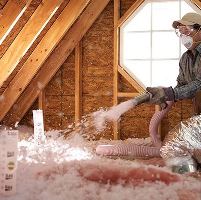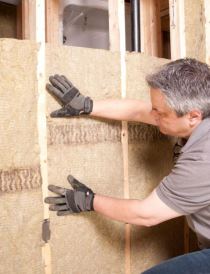
Fiberglass, Cellulose, or Foam: Which Is the Right Insulation Material for You?
As the insulation industry is taking strides toward sustainability, it's crucial to educate yourself on the eco-friendly merits and insulation credentials of each material.
Insulation greatly decreases the amount of energy we use, keeping our homes comfortable throughout the year. It’s a critical addition to protecting the environment in our daily lives. Here, we examine the three main types of insulation — fiberglass, cellulose, and foam — and weigh the pros and cons of each. We also look at some of the alternative insulation materials, including their "green" credentials compared to traditional materials.
Decode the R-values
 R-values tell you how well a type of insulation prevents heat transfer. Typically, the thickness and density of the material determine the R-value. The higher the R-value, the better the material will insulate. The number is presented per inch, so an R-value of 3.1 at 12 inches would provide an overall value of R-38. The chart below offers guidelines for R-values based on where you live and what you are insulating. Whenever possible, choose the material with the highest R-value to get the most out of your insulation.
R-values tell you how well a type of insulation prevents heat transfer. Typically, the thickness and density of the material determine the R-value. The higher the R-value, the better the material will insulate. The number is presented per inch, so an R-value of 3.1 at 12 inches would provide an overall value of R-38. The chart below offers guidelines for R-values based on where you live and what you are insulating. Whenever possible, choose the material with the highest R-value to get the most out of your insulation.
(The Regional R-Values chart is available here.)
Where to Insulate
The most vulnerable areas for heat loss in your home include the attic, outer walls, and crawl spaces. You might also consider insulating your hot water pipes to prevent freezing, or your water heaters and HVAC vent ducts to prevent energy loss. If these areas are already insulated, you can add extra layers or replace outdated materials to decrease your home's energy consumption.
Choose Your Material
Many factors will determine which type of insulation to choose, including your home’s construction and the type of insulation already in place. Here are some of the most popular options:
Fiberglass
Fiberglass is a mineral fiber created from recycled glass, sand, and other materials. It is available in three types:
- Blown-in. If you are insulating an attic or wall cavities, blowing the insulating material in using pneumatic equipment ensures maximum coverage. You can also apply it over existing insulation. Blown-in fiberglass has an R-value of 2.2 to 2.7 per inch.
- Batts. Fiberglass batts and rolls are ideal for placement between framing during construction in floors, walls, attics, and ceilings. They’re denser than blown-in insulation, offering an R-value of up to 4.3 per inch.
- Rolls. These can be precut to fit between studs and joists, making them great for attics and floors. You can also add a facing to the outward part of the material to act as a moisture barrier. Like batts, they offer an R-value of up to 4.3 per inch.
 There has been some concern about the health effects of fiberglass, as the fibers can easily be inhaled. However, it is not classified as a carcinogen, and once it's installed safely behind Sheetrock and plaster, breathing it in is no longer an issue. If you're installing it yourself, be sure to wear pants, long sleeves, protective eye gear, work gloves, and a face mask to limit your exposure. Some manufacturers even offer plastic-wrapped rolls to cut down on dust during insulation and act as a vapor barrier once installed.
There has been some concern about the health effects of fiberglass, as the fibers can easily be inhaled. However, it is not classified as a carcinogen, and once it's installed safely behind Sheetrock and plaster, breathing it in is no longer an issue. If you're installing it yourself, be sure to wear pants, long sleeves, protective eye gear, work gloves, and a face mask to limit your exposure. Some manufacturers even offer plastic-wrapped rolls to cut down on dust during insulation and act as a vapor barrier once installed.
Additionally, manufacturers are now using as much as 30 percent recycled glass in their fiberglass and significantly reducing the number of volatile organic compounds (VOCs), such as formaldehyde, used in production. Fiberglass is increasingly becoming a greener option, and it’s one of the most affordable insulation materials available.
Cellulose
 Cellulose is an alternative to blown-in fiberglass. It's a fiber made from around 80 to 85 percent recycled paper. Cellulose is denser than blown-in fiberglass, so it has a better R-value — about 3.2 to 3.8 per inch, however, it does settle and flatten over time, losing some of that insulating value. Because paper is flammable, cellulose insulation needs to be treated with borate and/or ammonium sulfate so that it can be used safely. Even though it’s a recycled material, the addition of chemicals counteracts some of its eco-friendly benefits.
Cellulose is an alternative to blown-in fiberglass. It's a fiber made from around 80 to 85 percent recycled paper. Cellulose is denser than blown-in fiberglass, so it has a better R-value — about 3.2 to 3.8 per inch, however, it does settle and flatten over time, losing some of that insulating value. Because paper is flammable, cellulose insulation needs to be treated with borate and/or ammonium sulfate so that it can be used safely. Even though it’s a recycled material, the addition of chemicals counteracts some of its eco-friendly benefits.
Foam
 Foam insulation comes in two forms: rigid panels and spray foam. Its R-values range from 4.0 to 6.5 per inch. Foam insulation expands, meaning it can seek out every nook and cranny that might be leaking air. When the foam seals, the R-value spikes to twice that of cellulose and fiberglass. Uniform thickness is the only way to guarantee optimal R-value. You’ll get the best results by hiring a professional to install it.
Foam insulation comes in two forms: rigid panels and spray foam. Its R-values range from 4.0 to 6.5 per inch. Foam insulation expands, meaning it can seek out every nook and cranny that might be leaking air. When the foam seals, the R-value spikes to twice that of cellulose and fiberglass. Uniform thickness is the only way to guarantee optimal R-value. You’ll get the best results by hiring a professional to install it.
While foam insulation offers lots of insulating value, it contains polyurethane, which is a potent VOC. The EPA has stated it can cause or aggravate some respiratory problems. Keep your home well-ventilated during installation and allow the time required by the manufacturer for the VOCs to dissipate.
Alternative Options
Other insulation options could be considered "greener" than traditional materials, but it's important to weigh the eco-friendly payoff if they don't provide as much R-value.
 An alternative to fiberglass batts and rolls is rock wool insulation (R-value 3 to 3.3 per inch). Rock wool usually contains 85 percent postindustrial recycled content, and it doesn't need additional chemicals to make it fire retardant.
An alternative to fiberglass batts and rolls is rock wool insulation (R-value 3 to 3.3 per inch). Rock wool usually contains 85 percent postindustrial recycled content, and it doesn't need additional chemicals to make it fire retardant.
Cotton insulation (R-value 3.4 per inch) — sometimes sold as denim insulation — is an increasingly popular alternative for batts and rolls. Look for a manufacturer that uses 80 percent or more recycled cotton, because although cotton is a renewable resource, it takes a lot of energy to produce. Sheep wool is another green option, though it needs chemical treatment to resist fire, pests, and mold.
As the insulation industry is taking strides toward sustainability, it's crucial to educate yourself on the eco-friendly merits and insulation credentials of each material.
An award-winning freelance journalist, Jennifer Tuohy has written for newspapers, magazines, marketing, and online content for more than 15 years. She covers a variety of subjects, but her passions lie in technology, sustainability, and the intersection of the two. She writes for The Home Depot, which carries a wide selection of insulation options to help your home be as energy efficient as possible.